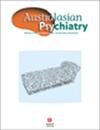分析塔斯马尼亚州一家公立医院精神科病房中精神疾病的性质和抗精神病药物处方的模式
IF 1.2
4区 医学
Q4 PSYCHIATRY
引用次数: 0
摘要
目的我们对塔斯马尼亚州霍巴特市一家精神科住院病房的抗精神病药物处方进行了评估,以确定使用模式、与其他精神科病房或中心的一致性以及澳大利亚和新西兰皇家精神医学院临床实践指南中的建议,并确定多重用药的预测因素。对霍巴特皇家医院(RHH)精神健康住院部在2021年2月1日至2021年8月1日期间出院的118名患者的数据进行了评估。如果排除小剂量的奥氮平和喹硫平辅助用药("PRN"),APP比例为35%。年龄和精神分裂症诊断可预测 APP。46%的患者使用了长效注射剂(LAI)。最常见的长效注射剂是利培酮(52%)。出院时,抗精神病药物的日平均剂量为529毫克氯丙嗪(CPZ)当量。13%的患者使用大剂量抗精神病药物(每天超过1000毫克氯丙嗪当量)。然而,应继续对抗精神病药物处方进行监测,以确保其符合最佳实践指南。本文章由计算机程序翻译,如有差异,请以英文原文为准。
Characterising the nature of psychiatric disorders and patterns of antipsychotic medications prescribed in a psychiatric ward in a public hospital in Tasmania
ObjectiveWe present an evaluation of antipsychotic prescribing in an inpatient psychiatry ward in Hobart, Tasmania, to establish pattern of use, alignment with other psychiatric wards or centres and the recommendations in the Royal Australian and New Zealand College of Psychiatry Clinical Practice Guidelines, and to determine predictors of polypharmacy.MethodsA descriptive cross-sectional survey design was used. Data from 118 patients discharged from the Royal Hobart Hospital (RHH) Mental Health Inpatient Unit between 01/02/2021 to 01/08/2021 were evaluated.ResultsAntipsychotic polypharmacy (APP) was observed in 40% of patients. When low doses of adjunctive (‘PRN’) use of olanzapine and quetiapine were excluded, the APP proportion was 35%. APP was predicted by age and by a schizophrenia diagnosis. Long-acting injections (LAIs) were used in 46% of the patients. The most common LAI was risperidone (52%). Average daily dose of antipsychotic at the time of discharge was 529 mg chlorpromazine (CPZ) equivalents. High dose antipsychotics (more than 1000 mg CPZ equivalents per day) was observed in 13% of the patients.ConclusionsThe observed prescribing practice is consistent with other clinical settings. Antipsychotic prescribing practice should, however, continue to be monitored to ensure adherence to best practice guidelines.
求助全文
通过发布文献求助,成功后即可免费获取论文全文。
去求助
来源期刊

Australasian Psychiatry
医学-精神病学
CiteScore
2.80
自引率
5.60%
发文量
159
审稿时长
6-12 weeks
期刊介绍:
Australasian Psychiatry is the bi-monthly journal of The Royal Australian and New Zealand College of Psychiatrists (RANZCP) that aims to promote the art of psychiatry and its maintenance of excellence in practice. The journal is peer-reviewed and accepts submissions, presented as original research; reviews; descriptions of innovative services; comments on policy, history, politics, economics, training, ethics and the Arts as they relate to mental health and mental health services; statements of opinion and letters. Book reviews are commissioned by the editor. A section of the journal provides information on RANZCP business and related matters.
 求助内容:
求助内容: 应助结果提醒方式:
应助结果提醒方式:


